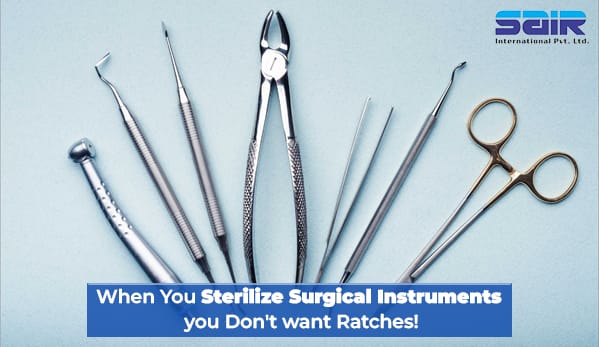In the world of healthcare, precision and reliability are paramount. Every component of a surgical procedure, from the skills of the medical team to the tools they use, plays a critical role in ensuring the safety and well-being of patients. Among these tools, surgical instruments stand out as vital assets that must be meticulously maintained. A common yet often overlooked challenge in maintaining these instruments is the issue of “ratches.” But what exactly are ratches, and why are they a problem when you sterilize surgical instruments? Let’s delve into this important topic.
Understanding Ratches in Surgical Instruments
“Ratches” is a term often used to describe the unintended buildup of residues, contaminants, or mechanical issues in the ratchet mechanisms of surgical instruments. Ratchets are the toothed mechanisms found in instruments like needle holders, hemostats, and clamps, which allow for precise control and locking. While these mechanisms are designed for precision, they can become problematic if not properly cleaned and sterilized.
Ratches can manifest in several ways:
- Residue Build-Up: Blood, tissue, and other biological materials can accumulate in the grooves of the ratchet mechanism.
- Rust or Corrosion: Improper cleaning and drying can lead to the formation of rust, weakening the instrument and potentially contaminating surgical sites.
- Mechanical Failure: Residues or damage can cause the ratchet to stick or fail to lock securely, compromising its functionality during critical procedures.
The Importance of Properly Sterilizing Surgical Instruments
Sterilization is the cornerstone of infection control in healthcare. Properly sterilizing surgical instruments ensures they are free of pathogens, protecting both patients and healthcare professionals from infections. However, the effectiveness of sterilization depends heavily on the pre-cleaning process and the condition of the instruments themselves.
When ratches are present, sterilization becomes less effective for several reasons:
- Shielded Contaminants: Residue trapped in the ratchet mechanism can shield pathogens from exposure to sterilizing agents.
- Incomplete Cleaning: The intricate design of ratchets makes them challenging to clean thoroughly without proper tools and techniques.
- Surface Damage: Corrosion or damage to the ratchet can create microabrasions that harbor bacteria, making sterilization less effective.
Best Practices to Sterilize Surgical Instruments Effectively
To ensure surgical instruments are free of ratches and ready for use, it is essential to follow a comprehensive cleaning and sterilization protocol. Here are some best practices:
- Immediate Rinse: After a procedure, instruments should be rinsed immediately to prevent biological materials from drying and adhering to surfaces. Use cold water to avoid coagulating proteins.
- Manual Cleaning: Use soft brushes, detergents, and enzymatic cleaners to remove residues. Pay special attention to the ratchet mechanism, ensuring all grooves are thoroughly cleaned.
- Ultrasonic Cleaning: Ultrasonic cleaners are particularly effective for cleaning ratchets. These devices use high-frequency sound waves to create microscopic bubbles that dislodge debris from hard-to-reach areas.
- Inspection: After cleaning, inspect each instrument carefully. Check for residues, rust, and mechanical issues in the ratchet mechanism. Instruments that show signs of wear or damage should be repaired or replaced.
- Lubrication: Use instrument-specific lubricants to maintain the smooth operation of ratchets. This step helps prevent mechanical issues and reduces wear over time.
- Sterilization: Choose the appropriate sterilization method based on the instrument’s material and design. Common methods include steam autoclaving, chemical sterilization, and plasma sterilization. Ensure instruments are properly positioned in the sterilizer to allow sterilizing agents to reach all surfaces, including the ratchet mechanism.
- Storage: After sterilization, store instruments in a clean, dry environment. Use protective cases or trays to prevent damage and contamination.
Consequences of Not Properly Sterilizing Surgical Instruments
Failing to address ratches in surgical instruments can have serious consequences for both patients and healthcare providers. These include:
- Increased Risk of Infection: Contaminated instruments can introduce pathogens into surgical sites, leading to infections that may complicate recovery and, in severe cases, result in life-threatening conditions.
- Compromised Patient Safety: A malfunctioning instrument, such as a clamp that won’t lock due to a faulty ratchet, can disrupt surgical procedures and put patients at risk.
- Legal and Financial Repercussions: Infections and surgical errors caused by poorly maintained instruments can lead to lawsuits, reputational damage, and increased costs for healthcare facilities.
- Shortened Instrument Lifespan: Neglecting proper care can result in premature wear and tear, necessitating frequent replacements and increasing operational costs.
Innovations in Instrument Maintenance
To combat the issue of ratches and improve overall instrument maintenance, the medical industry has embraced various innovations:
- Advanced Cleaning Technologies: New ultrasonic cleaners, automated washers, and enzymatic solutions are designed to tackle even the most stubborn residues in complex instrument designs.
- Enhanced Instrument Design: Manufacturers are developing surgical instruments with fewer crevices and improved materials that resist corrosion and are easier to clean.
- Digital Tracking Systems: Some healthcare facilities now use digital systems to monitor instrument maintenance. These systems track cleaning, sterilization, and repair histories, ensuring no instrument is overlooked.
- Education and Training: Ongoing training programs for sterilization technicians emphasize the importance of addressing ratches and maintaining high standards of cleanliness.
A Shared Responsibility
Maintaining surgical instruments is a shared responsibility that involves everyone in the healthcare ecosystem. From manufacturers who design instruments to technicians who clean and sterilize them, each step is crucial in ensuring these tools function as intended.
Surgeons and healthcare providers can also play a role by:
- Reporting issues with instruments promptly.
- Participating in training sessions on instrument care.
- Advocating for investment in high-quality instruments and maintenance equipment.
Conclusion
When it comes to sterilizing surgical instruments, ratches are more than just a nuisance; they’re a threat to patient safety and surgical success. By understanding the challenges posed by ratches and implementing best practices for cleaning and sterilization, healthcare facilities can ensure their instruments are safe, reliable, and ready for every procedure.
Addressing ratches is not just about maintaining equipment—it’s about upholding the highest standards of care and protecting the lives of patients who depend on these critical tools. So, the next time you think about surgical instruments, remember: when you sterilize surgical instruments, you don’t want ratches!


